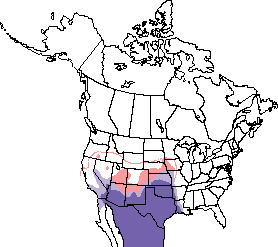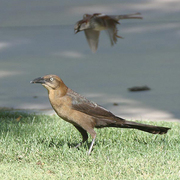Great-tailed Grackle
General Description
Abundant and highly visible year round in a variety of open, rural and urban landscapes in Mexico, Central America, and coastal northern South America, the Great-tailed Grackle has been extending its range northward and westward for the last hundred years and is now resident in the United States from Texas to Iowa and California. It is annual, and has nested, in Oregon, and is a rare resident breeder in southern Idaho. Washington has four accepted records (earliest 1987) and there are at least two records from British Columbia (earliest 1979).
The adult male is glossy black with a yellow eye and a bluish-purple sheen on the head and back. The adult female, considerably smaller, is brown with buffy underparts and a pale eye. Both sexes have a keel-shaped tail, which is especially long in the male. The male somewhat resembles a Common Grackle but is much larger and longer-billed, with a purplish rather than a bronzy sheen on the back. The tail is also proportionally longer—as long as the body, or even longer. The female looks a bit like the female Brewer’s Blackbird but is much larger, longer-billed and longer-tailed, with a pale rather than a dark eye.
Revised November 2007
North American Range Map


Family Members
 BobolinkDolichonyx oryzivorus
BobolinkDolichonyx oryzivorus Red-winged BlackbirdAgelaius phoeniceus
Red-winged BlackbirdAgelaius phoeniceus Tricolored BlackbirdAgelaius tricolor
Tricolored BlackbirdAgelaius tricolor Western MeadowlarkSturnella neglecta
Western MeadowlarkSturnella neglecta Yellow-headed BlackbirdXanthocephalus xanthocephalus
Yellow-headed BlackbirdXanthocephalus xanthocephalus Rusty BlackbirdEuphagus carolinus
Rusty BlackbirdEuphagus carolinus Brewer's BlackbirdEuphagus cyanocephalus
Brewer's BlackbirdEuphagus cyanocephalus Common GrackleQuiscalus quiscula
Common GrackleQuiscalus quiscula Great-tailed GrackleQuiscalus mexicanus
Great-tailed GrackleQuiscalus mexicanus Brown-headed CowbirdMolothrus ater
Brown-headed CowbirdMolothrus ater Orchard OrioleIcterus spurius
Orchard OrioleIcterus spurius Hooded OrioleIcterus cucullatus
Hooded OrioleIcterus cucullatus Bullock's OrioleIcterus bullockii
Bullock's OrioleIcterus bullockii Baltimore OrioleIcterus galbula
Baltimore OrioleIcterus galbula Scott's OrioleIcterus parisorum
Scott's OrioleIcterus parisorum

